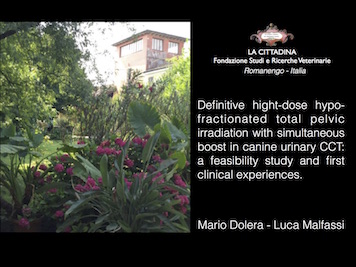DEFINITIVE HIGH-DOSE HYPO-FRACTIONATED TOTAL PELVIC IRRADIATION WITH SIMULTANEOUS BOOST IN CANINE URINARY CCT: A FEASIBILITY STUDY AND FIRST CLINICAL EXPERIENCES
Introduction
The lower urinary tract transitional cell carcinoma (CCT) poses challenge in order to the appropriate radiotherapy (RT) regimen. Organs at risk (OARs) within the irradiation field (ureters, rectum) are the limiting factors in dose escalation. The primary aim of this study was to evaluate the technical feasibility of high-dose hypo-fractionated dynamic IMRT in non-resectable lower urinary CCT affected dogs. The secondary goal was to evaluate the toxicity and the efficacy of the RT regimens.
Methods
Three dogs with lower urinary tract CCT were treated with definitive high- dose hypo-fractionated RT with VMAT technique. The volume treatment definition include the gross tumor (GTV), the PTV1 (GTV+3mm), limphatics (PTV2), the entire bladder, prostate in males and uretra (PTV3), the entire pelvis except the rectal volume (PTV4). Dose prescriptions were 40 Gy to PTV1, 38 Gy to PTV2, 34 Gy to the PTV3, 30 Gy to the PTV4, in 6 fractions on alternate days. A piroxicam was subministered to all dogs. Serial clinical and CT/MRI examination were performed. Disease control and toxicity effects were evaluated according to RECIST and VRTOG criteria.
Results
Three T2N0M0 urinary tract CCT were treated. Prescription goals were obtained in all three cases with V95%>95% and V107%>2%. During follow-up (mean 6 months) one partial response and two complete responses were obtained. Two grade I cystitis developed. Non rectal toxicity was recognized.
Conclusion
The initial experiences with the RT regimen adopted indicate a feasibility and effectiveness in lower urinary transitional cell carcinoma (CCT). Longer follow-up and larger treatment series are needed.
